
Just as two decades of relentless liberalisation has led to a rethinking on economic issues from the perspective of distributive justice, an excessive dose of the feel-good factor in the media has triggered an enquiry about the very purpose of the media.
Re-examining the state of the media could be a subject matter of a panel of experts or academics, but how about designing a course that ushers a whole new breed of journalists who question the very process of development, interrogate the people at the helm and turn the concept of progress on its head?
When NGO Samvada launched a course named ‘Archaeology of the Media’, in October last year, there were skeptics aplenty if the course would have any takers in the current mood of glitz and glamour that dominates the media discourse. But then people at Samvada had their ears to the ground.
Two decades of work among the youth in rural and semi-urban areas had opened them to volcanic churnings in the underbelly of Karnataka. And lo and behold! The first batch of journalists sensitised against the rapacity of current theories of development and skilled in raising inconvenient questions is about to graduate out of its humble premises in Yelahanka. And to boot, these scribes are trained to write and express themselves in Kannada.
Producing journalists is no big deal these days. A city like Bangalore today offers as many as 30 different courses in journalism and media. But people behind the Samvada-Baduku College and ‘Archaeology of the Media’ had no idea of adding just one more opportunity, albeit for the rural youth, in the world of media education. From the word go, the task before them was to groom a breed of media persons with their antennae sensitised against looking at things as they appeared. They were supposed to ‘unearth and investigate’, as an archaeologist would go about his task.
Says Sana Das, course director at Samvada, the foremost concern was to bring to the fore subaltern issues as well as to influence the profession itself. The issues were aplenty and the media in its current state, was indifferent to them, if not totally heedless.
“Floods in Gulbarga displaced thousands of families, and men folk from among them had streamed into cities of south Karnataka to find livelihood. But did anyone bother to look into their lot?”, questions Sana Das. The issues of the garment factory workers, pollution-affected communities, livelihood of communities whose crafts were losing relevance, people displaced from farms that were gobbled up by expanding cities were begging for attention.
Says Sana Das, the students were mostly drawn from the rural areas and were graduates, three of whom even had PG degrees. Hands-on training in audio-visual media as well as writing was a priority from day one. The students were asked to do projects in three different media, one each in community media, visual media and written media and two others of their own choice. The rigorous training within the short period of six months led to the production of 95 projects.
Unearthing stories
The trainees were trained to discover lies that statistics speak, ask questions that pertained to public interest and interrogate the authorities and make them feel accountable and to discover the other side of the supposedly objective treatment of news.
Attendant to the nature of the course was inculcating the habit of risk-taking among the group of students. Faculty member Janardhan K, says, “In short the students were asked to hone their skills in positive aggression and the course content was designed to raise critical inquiry in them. They are not expected to be cogs in wheels, but are supposed to walk the streets with eyes and the windows of the mind ever and wide open.”
But one could very well ask, if the journalists, both male and females hailing from rural areas, are not being subjected to learn too much too soon, given that the main course was encapsulated within six months. Besides, if the Kannada language could offer them such wide range of reading material.
Sana says, the students were provided a large amount of translated material from leading authors and Samvada envisions simultaneous development of a translation project in future to transmit material from authors such as Noam Chomsky, Edward Said, James Scott, Foucoult, and Ranjit Guha.
An interesting sidelight of the course is the e-seminar that puts all these issues of livelihood in the larger perspective of the realities of the South Asian region. The purpose of having a rubric on understanding the region is to provide grounding in significant historical issues that have constituted and seem to sustain conflicting relationships and violence in the region.
The students were able to engage in conversation with nearly 30 panellists from eight SAARC nations, mainly scribes, academics and thinkers on ideological, emotional, cultural, and geographical roots of the violence and the factors that mar the prospects of peace building. An open source Moodle-Samvada software enabled the students to interact with these panelists across the borders of a conflict-ridden region.
Anita Ratnam, director of Samvada feels that the course would enable the students to understand issues in the broader perspective of South Asia, thereby imbuing their writings with insight that help rather than hinder inclusive development of communities.